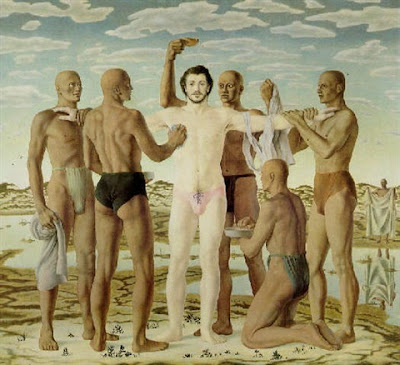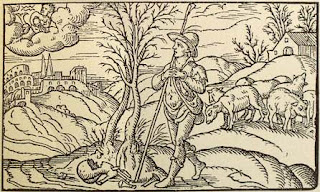Jared French. Artist and Hermeticist.
Jared French was born on February 4th, 1905, in Ossining, New York. Aquarian by birth. He studied music, visual art and literature at Amherst College from 1921-1925. The Amherst motto Terras Irradient would stand as a sign for his life as a painter, "Bring light to the Earth" as would his birth image. French's paintings in egg tempera are lit by radiance and the flux of water is a key archetypal symbol in his visual language. French became the lover and friend of Paul Cadmus and it is Cadmus' small and intimate portrait of him, in 1931, that introduces French to the world.
In this portrait much is coded. The viewer is placed in the lover's position, gazing down at a rumpled bed, suggesting rest after activity. The flowing, rotating hands intimate fluid energy in balance. And the fingers are bookmarks in an early edition of James Joyce's Ulysses, a book which was smuggled into the USA for the literary minded French. The illegal novel stands for another illegality: the love of two men.
French protected his work avidly. He made few written statements about his art and said little about his life. His life and art was hermetically sealed, consciously so, and he remains an important artist who is mainly mis-understood. As Nancy Grimes has pointed out in Jared French's Myths (1993), French is mistakenly seen as a Magic Realist, an error that goes entirely in the wrong direction as regards his work. Magic Realism sought to present realistic views that had opened up to moments of magic. There is an objectivity underneath Magic Realism. French's main work, from 'Washing the White Blood from Daniel Boone" onwards (1939) woke up to a subjective, hermetical symbolism that told mythological narratives. The paintings awake magic/imagination with reality through emblematic symbolism.
"Washing the White Blood from Daniel Boone" describes a moment in USA history: it is 1778 and Boone has been abducted by the Shawnee and inducted into their life.
But the historical moment is transfigured by French into an archetypal narrative. Boone, like Pierro della Francesca's Christ, awaits to be baptised. The native figure who holds the cup above Boone's head is modelled on John the Baptist. Piero della Francesca's asexual angels have become masculine warriors. With a touch of humour, an implicit connection is made between French and Francesca, the "French-man" such that the new painting becomes a moment of spiritual crisis in French's personal mind and the American psyche. Two of the attendants, like Greek caryatids support the body of Boone and support his weight easily. Whereas the Renaissance French-man depicted Christ in a moment of prayer, awaiting the Holy Ghost, French's Boone adopts a stature that echoes The Crucifixion. This is a cross-roads moment for the adventurer. There has been a tendency to read the painting as one of "service" in which the black figures serve the needs of the white. Nancy Grimes rightly reads against this view, seeing that the physical Shawnee figures are in control and in the process of awakening Boone. But she possibly goes astray in jumping too quickly into Jungian terms and seeing this as a painting about how the white man/white history must enter the black underworld of the unconscious (as typefied by the black attendants) to be cleansed. There is nothing dark about this painting -- it is a well-lit day -- and there is no hint of the psychic disunity that comes with subconscious immersion. For French, Boone's whiteness alludes to a body clothed from sunlight, but here open to to it. The alchemical ablutio washes away his accumulated psychic dirt and presents him with a new solar consciousness. Boone's uncomfortable pink, fleshly, infant innocence is faced with a mature sexuality, one that he has not yet learnt to face: his gaze looks straight on and does not engage with his attendants, though they all observe him.
If the figures are read from left to right, the eye starts with the figure holding the towel, passes along the arms of Boone, turns at the figure holding the material towards the figure who washes, then to the figure who pours and the figure who kneels and holds the bowl of water. This kneeling figure begins an upward journey of energy back to the starting point. Hermetically, this movement is the ritual pentagram that invokes water and fits with the painting's focus on psychic and cultural cleansing. In her preface to Jared French's Myths, Nancy Grimes notes that though he was a talented figurative artist like the others in his circle of artists, Cadmus, Perlin and Tooker, French drew his figures according to Renaissance proportions inspired by Leon Battista Alberti.
Mid-career, 1940s-1950s, French began a categorisation of his symbolical world. He envisaged 7 categories (rather like the 7 Liberal Arts of the Medieval and Renaissance World). Each of these categories sub-divided into 7 functions giving 49 contents all in all. This hermetical framework, with echoes of the Red Rose of the Rosy Cross and its 49 petals, was a grid of references, some of which became paintings. The category "Creation" was split into Chaos, Decoration, Painting, Prose, Poetry, Music and Sculpture.
It is unfortunate that French's paintings are largely unknown today and surface only superficially in the world of imagery. The re-creation of "The Double" as a fashion campaign by Dolce and Gabbana is an act of profanity and stupidity.



Comments